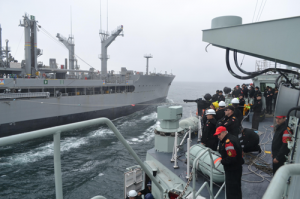Sea Training prepares HMCS Vancouver for success
By Lookout on Jul 27, 2015 with Comments 0

The crew of HMCS Vancouver practices Replenishment at Sea manouvers with Chilean Navy ship Almirante Montt.
To prepare HMCS Vancouver for its ongoing Replenishment at Sea (RAS) operations with the Chilean Navy, the Commander of Sea Training (Pacific), Cdr Chris Peschke, and a team of eight instructors have designed and implemented at-sea training for participating sailors.
“We use the expression ‘showing people what right looks like’ to explain how we take a ship’s crew and help build their skills to a certain level so they can continue with training and development on their own,” says Cdr Peschke.
“Sea Training opens the door and the ship does the rest.”
On any work-up or at-sea training period, Sea Training instructors board a ship to provide individualized overview, instruction and debriefing on basic seamanship, navigation, exit from the harbour, and a range of safety precautions such as man overboard procedures.
The training aims to bring a crew’s capability to multi-threat warfare or serious damage control.
“We assess the threats a ship is going to face, the area of the world she’s going to be operating in, and then we develop a specific training work up so the ship is comfortable operating when it gets there.”
In HMCS Vancouver’s work with Almirante Montt, Cdr Peschke says his team has faced the challenge of training for the specifics of RAS operations.
Though routine, the operation is risky.
It involves stringing steel cables under 5,000 pounds of tension between a replenishment tanker and a receiving ship.
Then heavy pallet loads are sent across with food, fuel and ammunition.
Cdr Peschke and his team utilized the Sea Training Guide, Combat Readiness Requirements and past experience to design a program that increases in complexity as the training goes on.
“We started off with two ‘dry hook-ups’ where hoses were passed from [Chilean ship] Almirante Montt to HMCS Vancouver to practice transferring fuel. It’s the most important capability, and we practiced it at night as well,” says Cdr Peschke.
His instructors then oversaw the multi-station replenishment in which fuel, ammunition and food were transferred simultaneously all while conducting flight operations with Vancouver’s Sea King helicopter.
They worked closely with the bridge team to orchestrate bringing Vancouver alongside Almirante Montt at the uncomfortably close range of 150 feet.
“At one point we carried out four replenishments in a single day. It was taxing work and we were pretty tired after that,” Cdr Peschke says with a laugh.
Sea Training instructors also provided instruction to the engine room crew and those responsible for emergency steering. Seamless cooperation between these two departments and the bridge crew is critical to successful replenishment operations.
“We’re training the next generation of sailors here,” says Cdr Peschke. “We made sure that as many junior officers as possible were present for training so that our pool of knowledge grows and future ships know how to keep themselves safe.”
Having Almirante Montt here to train crews on this critical operation enables personnel on this coast to maintain their proficiency.
“RAS can be an extremely dangerous operation and it takes a lot of practice to reduce the risks both to individual people and to each ship as a whole.”
Operations practised at night added the challenges of minimized depth perception and visibility to the already challenging task of two tethered ships maintaining the same speed and direction.
Varying weather conditions, such as fog, gave the crew a realistic glimpse into the adverse conditions they could expect while performing future RAS operations.
“Other risks involved are the swinging of the heavy load pallets, the transferring of highly flammable fuel and keeping humans from getting in between anything metal and heavy,” says Cdr Peschke.
He says the Royal Canadian Navy’s close alliance and past experience working with the Chilean Navy has helped mitigate those risks and reinforced the training, which has gone smoothly so far.
Ultimately, the at-sea training prepares sailors to pass on their skills to junior crew members, says Cdr Peschke.
“There is lots of instruction written down in books for carrying out operations, but when it comes down to the art of actually being at sea, that’s hundreds of years of knowledge being passed from one generation to the next through hands-on practice.”
Rachel Lallouz
Staff Writer
Filed Under: Top Stories
About the Author:





